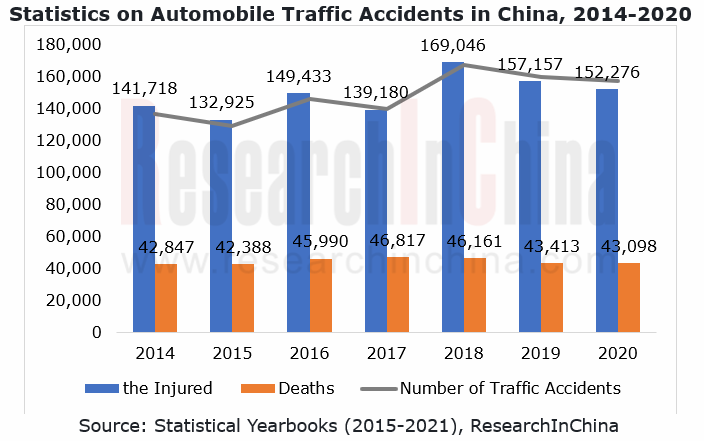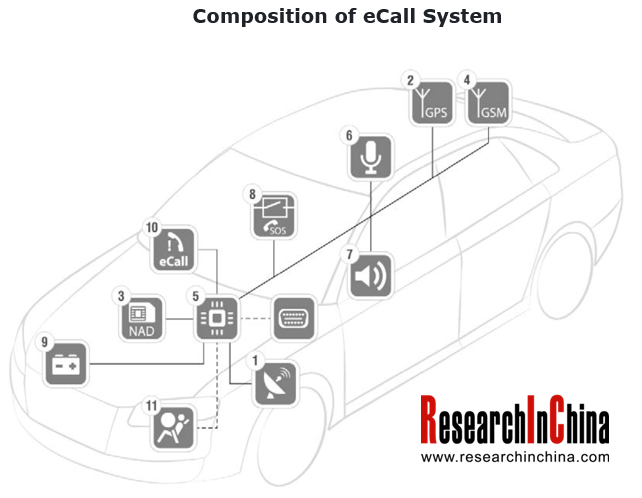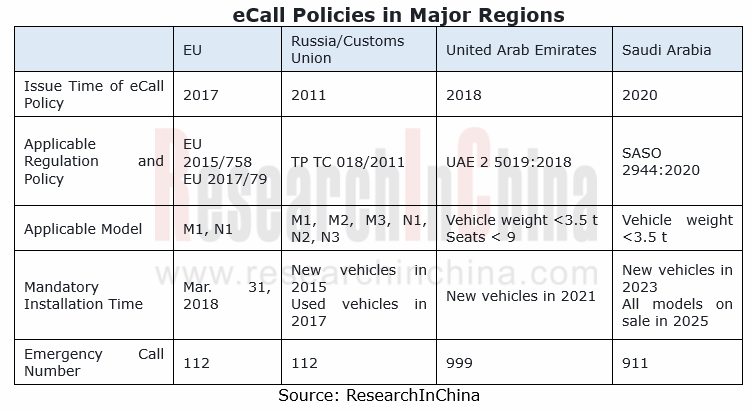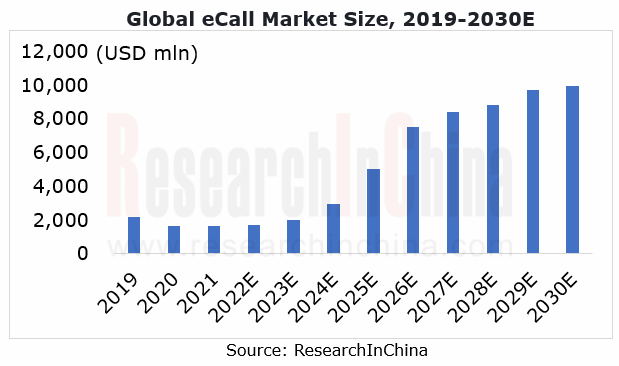Global and China Automotive Emergency Call (eCall) System Market Report, 2022
Automotive eCall system: wait for the release of policies empowering intelligent connected vehicle safety
At the Two Sessions held in March 2022, more than 10 deputies to the National People's Congress (NPC) and members of the Chinese People's Political Consultative Conference (CPPCC) put forward over 30 proposals on the development of the automotive industry, above 80% of which relate to the development of intelligent connected vehicles. The issues about strengthening the safety of intelligent connected vehicles were mentioned many times.
Yin Tongyue, chairman of Chery, suggested that the Ministry of Industry and Information Technology (MIIT) take the lead in promoting the release of eCall (Emergency Call or Accident Emergency Call System) regulations at the earliest possible time, and give some subsidies to companies for a faster progress in promotion and implementation while carrying out the regulations.
A total of over 30 million people have died in car crashes worldwide since the car made its debut, according to the World Health Organization. The data in statistical yearbooks show that in recent years there are more than 150,000 to 160,000 traffic accidents causing casualties in China annually, with around 40,000 deaths. In traffic accidents, the vast majority (above 90%) of all the dead lost their lives before reaching hospitals. Yet the injured who were successfully delivered to hospitals were very likely to be rescued. In Japan where the timely rescue rate (the rate of rescues within 30 minutes) reaches as high as 98%, the traffic fatality rate is as low as 0.9%, justifying how important it is to introduce mandatory eCall regulations.

An automotive emergency call system can provide the user with eCall rescue services (GNSS positioning and voice call services) in the event of an emergency, and it can be activated manually and automatically. The manual eCall function is enabled by a physical button; automatic eCall refers to a function in which the eCall system receives the signal and automatically makes an emergency call after a traffic accident happens. After the eCall system dials, the backstage will arrange the responsive rescue services in time according to the location of the vehicle.
A typical eCall system is at least composed of the following: 1. GNSS receiver; 2. GNSS antenna; 3. NAD (Network Access Device, including SIM card); 4. mobile network antenna; 5. ECU/MCU; 6. microphone; 7. speaker/emergency pager; 8. manual button; 9. battery or power supply system; 10. warning or indicating device; 11. collision detection system (sensor).

eCall policies have come into force in quite a few Eurasian countries.
In 2005, the European Commission made a request for developing an in-vehicle emergency call (eCall) service, aiming to implement and deploy a unified automotive eCall service system in Europe. To that end, in 2005 the European Commission assigned the technical standard task to ETSI/3GPP (European Telecommunications Standards Institute, ETSI) to develop and build an eCall communication technology standard system.
In 2008, ETSI/3GPP began to release a range of eCall communication module technology standards. In 2011, nine European countries co-founded the HeERO (Pan-European In-Vehicle Emergency Call Service) Consortium. The EU issued the Regulation (EU) 2015/758 in 2015, and introduced the Commission Implementing Regulation (EU) 2017/78 and the Commission Delegated Regulation (EU) 2017/79 in 2017. The EU eCall policies specify the mandatory installation of 112-based in-vehicle eCall systems in all new M1 and N1 vehicles from March 31, 2018.
Besides the EU, the Russia-led Customs Union, the United Arab Emirates and Saudi Arabia have also launched their eCall bills.

Since the introduction of UNECE-R144 in 2018, for new vehicle models, Japan has required mandatory installation of accident emergency call systems (AECS) in M1/N1 vehicles after the transition period of 1.5 years; for vehicles in production, Japan has required mandatory installation of AECS in M1/N1 vehicles after the transition period of 3 years. The AECS will save an average of 4 minutes of rescue time according to Japan’s official statistics. Meanwhile, the D-Cal system, Japan’s advanced rescue service, is expected to save 17 minutes on average.
India has also stipulated that from April 1, 2019, all passenger vehicles such as taxis and buses must be equipped with the device AIS 140 Tracker.
China’s eCall market is awaiting the accompaniment of policies.
In early 2022, we made a one-to-one discussion and communication with several Chinese experts from Tier1 suppliers on the development of eCall systems. We all made an optimistic prediction about the enforcement time of eCall policy, and roughly determined the timeline is between 2023 and 2024.
Automotive safety has always been a major concern of policies. The Telematics Industry Application Alliance (TIAA) announced the TIAA eCall solution in late 2015.
In 2013, the TIAA members, Huawei, HealthLink, Changan Automobile and BYD set up the "eCall Standard Working Group" to research and draft Chinese eCall standards. In June 2014, the key members of the working group including Changan Automobile, HealthLink, BYD, Chery and JAC held a joint demonstration of eCall systems in four places, verifying the stability and practical usability of China’s self-developed eCall system.
In 2016, Huawei and HealthLink led efforts to apply for project approval of the eCall standards researched by the TIAA.
In December 2017, the Automotive Electronics and Electromagnetic Compatibility Sub-Technical Committee of the National Technical Committee of Auto Standardization, organizing major automakers and related technical research institutions, convened the "Technical Seminar on Automotive Emergency Call" in Dali City of Yunnan Province, at which they discussed China's eCall technologies and the plans to advance eCall standards in China.
In January 2018, the MIIT solicited the public opinions on the mandatory national standard plan project—Automotive Accident Emergency Call Systems, on its website. This is the first time that a national authority that administrates the automotive industry has clearly defined eCall standard as a national standard (GB), that is, a mandatory national standard for the automotive industry.
In 2019, China Automotive Technology and Research Center Co., Ltd. led companies to organize several seminars on "Automotive Accident Emergency Call Systems". And in October 2019, it called a preparatory meeting for the drafting of the standard "Automotive Accident Emergency Call Systems", and clarified the main drafting content and schedule.
In 2020, the national standard plan "Automotive Accident Emergency Call Systems" was reported by TC114 (National Technical Committee of Auto Standardization), to the competent authority the MIIT. The main drafters included China Automotive Technology and Research Center Co., Ltd., the Traffic Management Research Institute of the Ministry of Public Security, the SAMR Defective Product Administrative Center, China Academy of Information and Communications Technology, Great Wall Motor Co., Ltd., and Huawei Technologies Co., Ltd. Publicity started on October 29, 2020, and ended on November 28, 2020.
In December 2021, the second meeting on the automotive standard system of the Automotive Accident Emergency Call Systems (AECS) in 2021 was held in Tianjin. The meeting discussed and ascertained the plan for construction of corpus and background noise libraries related to the GB/T "Requirements and Test Methods for Road Vehicle Hands-free Call and Voice Interaction Performance", to foster a well-established automotive accident emergency call system (AECS) standard system, in a bid for a louder voice of China in this field.
In March 2022, the MIIT released the key tasks of automotive standardization in 2022, including accelerating the formulation of standards for hands-free call and voice interaction and starting the filing of the standard Automotive Accident Emergency Call Systems.
The global eCall market is mainly driven by policies. At present, the market is concentrated in the EU, Russia and other places that have issued eCall policies. Still amid the pandemic in 2021, as the automobile shipments had yet to recover to the level before the COVID-19 and eCall still used 2G/3G modules, the declining average price of the system led to an overall flat market size (by value) in the year, in spite of a slight increase in eCall system shipments. It is conceivable that the global eCall system market will be worth USD1,678 million in 2022, up by 4% versus 2021, and will grow to USD9,931 million in 2030, mainly thanks to the rebound in the automotive market and new eCall markets such as Saudi Arabia and China, a country which will introduce eCall polices on one optimistic estimate.

Supply goes before troops, players makes beforehand deployments in eCall market.
The EU goes earlier in formulation of eCall system standards, with a high demanding on system reliability, but not requiring 4G/5G networks for communications. Currently, European eCall products still mainly use 2G/3G modules, so CAT1 communication modules are fully competent. Some low-end vehicle models are not equipped with products with intelligent connectivity feature, but only eCall products capable of basic communications (Entry Telmatics). Many mid- and high-end models, of course, pack 4G T-Box that integrates eCall function, which is commonplace for intelligent connected vehicles.
In the international market, the key eCall system suppliers are still traditional automotive electronics manufacturers like Continental Automotive, Bosch, Valeo and LG Electronics. In the absence of relevant regulations in China, neither OEMs nor Tier1s have much incentive to promote eCall systems in the country. But we still see the following types of local players active in the eCall system market:
First, companies like Huawei. On the strength of their own experience in communication and automotive electronics, they have partaken in policy formulation, and have developed and applied for technology patents. In 2016, Huawei filed for an eCall patent (application number: CN2016100997921), a method for supporting emergency call (eCall). On October 25, 2021, Desay SV applied for a patent titled "An eCall System Terminal with A Video System and Rescue Method" (application number: CN202111243707.1).
Second, players like Flaircomm Microelectronics. With its expertise in communication modules and T-Box, the company cooperates with local Chinese OEMs to provide eCall systems for products China exports to countries/regions having introduced eCall policies, such as the EU, the Middle East, and Russia. Flaircomm Microelectronics is the first one in China to pass (EU) 2015/758, UNECE R144 and UAE.S 5019:2018 certifications. It provides eCall system solutions for Chinese automakers like SAIC, Geely, GAC, Chery, BYD and Changan Automobile, all of which export vehicles to other countries.
Third, those like Shenzhen Discovery Technology Co., Ltd. They provide eCall security services for car owners, by integrating resources and starting with the aftermarket. Zhuque No. 1, a product jointly launched by Discovery Technology, Silhorse and HealthLink, delivers emergency rescue services for car owners using an AM eCall device and HealthLink’s rescue network.
OEMs and Tier 1 Suppliers' Cost Reduction and Efficiency Enhancement Strategy Analysis Report, 2025
ResearchInChina released the "OEMs and Tier 1 Suppliers' Cost Reduction and Efficiency Enhancement Strategy Analysis Report, 2025", summarizing hundreds of cost reduction strategies to provide referen...
Automotive Fixed Panoramic Sunroof and Smart Roof Research Report, 2025
With the intelligent application of car roofs as the core, this report systematically sorts out a series of new products such as fixed panoramic sunroof/openable sunroof, ceiling screen, roof ambient ...
Automotive-Grade Power Semiconductor and Module (SiC, GaN) Industry Research Report, 2025
SiC/GaN Research: Sales volume of 800V+ architecture-based vehicles will increase more than 10 times, and hybrid carbon (SiC+IGBT) power modules are rapidly being deployed in vehicles.
Sales volume o...
Cockpit Agent Engineering Research Report, 2025
Cockpit Agent Engineering Research: Breakthrough from Digital AI to Physical AI
Cockpit Agent Engineering Research Report, 2025 starts with the status quo of cockpit agents, summarizes the technical ...
Prospective Study on L3 Intelligent Driving Technology of OEMs and Tier 1 Suppliers, 2025
L3 Research: The Window of Opportunity Has Arrived - Eight Trends in L3 Layout of OEMs and Tier 1 Suppliers
Through in-depth research on 15 OEMs (including 8 Chinese and 7 foreign OEMs) and 9 Tier 1 ...
China Commercial Vehicle IoV and Intelligent Cockpit Industry Research Report 2025
Commercial Vehicle IoV and Cockpit Research: The Third Wave of Passenger Car/Commercial Vehicle Technology Integration Arrives, and T-Box Integrates e-Call and 15.6-inch for Vehicles
I. The third wav...
Intelligent Vehicle Electronic and Electrical Architecture (EEA) and Technology Supply Chain Construction Strategy Research Report, 2025
E/E Architecture Research: 24 OEMs Deploy Innovative Products from Platform Architectures to Technical Selling Points
According to statistics from ResearchInChina, 802,000 passenger cars with domain...
Research Report on Intelligent Vehicle Cross-Domain Integration Strategies and Innovative Function Scenarios, 2025
Cross-Domain Integration Strategy Research: Automakers' Competition Extends to Cross-Domain Innovative Function Scenarios such as Cockpit-Driving, Powertrain, and Chassis
Cross-domain integration of ...
China Autonomous Driving Data Closed Loop Research Report, 2025
Data Closed-Loop Research: Synthetic Data Accounts for Over 50%, Full-process Automated Toolchain Gradually Implemented
Key Points:From 2023 to 2025, the proportion of synthetic data increased from 2...
Automotive Glass and Smart Glass Research Report, 2025
Automotive Glass Report: Dimmable Glass Offers Active Mode, Penetration Rate Expected to Reach 10% by 2030
ResearchInChina releases the Automotive Glass and Smart Glass Research Report, 2025. This r...
Passenger Car Brake-by-Wire (BBW) Research Report, 2025
Brake-by-Wire: EHB to Be Installed in 12 Million Vehicles in 2025
1. EHB Have Been Installed in over 10 Million Vehicles, A Figure to Hit 12 Million in 2025.
In 2024, the brake-by-wire, Electro-Hydr...
Autonomous Driving Domain Controller and Central Computing Unit (CCU) Industry Report, 2025
Research on Autonomous Driving Domain Controllers: Monthly Penetration Rate Exceeded 30% for the First Time, and 700T+ Ultrahigh-compute Domain Controller Products Are Rapidly Installed in Vehicles
L...
China Automotive Lighting and Ambient Lighting System Research Report, 2025
Automotive Lighting System Research: In 2025H1, Autonomous Driving System (ADS) Marker Lamps Saw an 11-Fold Year-on-Year Growth and the Installation Rate of Automotive LED Lighting Approached 90...
Ecological Domain and Automotive Hardware Expansion Research Report, 2025
ResearchInChina has released the Ecological Domain and Automotive Hardware Expansion Research Report, 2025, which delves into the application of various automotive extended hardware, supplier ecologic...
Automotive Seating Innovation Technology Trend Research Report, 2025
Automotive Seating Research: With Popularization of Comfort Functions, How to Properly "Stack Functions" for Seating?
This report studies the status quo of seating technologies and functions in aspe...
Research Report on Chinese Suppliers’ Overseas Layout of Intelligent Driving, 2025
Research on Overseas Layout of Intelligent Driving: There Are Multiple Challenges in Overseas Layout, and Light-Asset Cooperation with Foreign Suppliers Emerges as the Optimal Solution at Present
20...
High-Voltage Power Supply in New Energy Vehicle (BMS, BDU, Relay, Integrated Battery Box) Research Report, 2025
The high-voltage power supply system is a core component of new energy vehicles. The battery pack serves as the central energy source, with the capacity of power battery affecting the vehicle's range,...
Automotive Radio Frequency System-on-Chip (RF SoC) and Module Research Report, 2025
Automotive RF SoC Research: The Pace of Introducing "Nerve Endings" such as UWB, NTN Satellite Communication, NearLink, and WIFI into Intelligent Vehicles Quickens
RF SoC (Radio Frequency Syst...